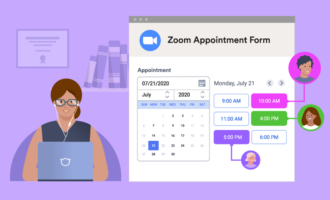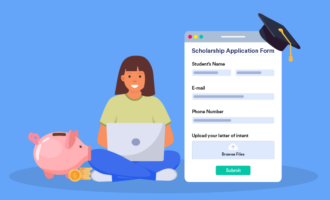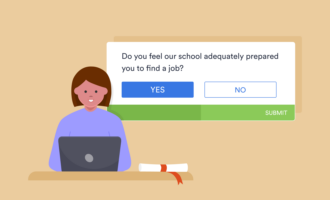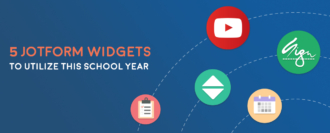It may seem like people spend most of their time online sharing cat memes on Facebook or watching TED Talks on YouTube. There may be some truth to that, but there’s also something much more important and meaningful happening in the digital sphere — online courses.
The world is witnessing an educational renaissance powered by Wi-Fi. Analysts project the value of the global e-learning market will be $325 billion by 2025. Today, you can learn just about anything with an online course. All you need is an internet connection and a laptop or phone.
The COVID-19 pandemic has only accelerated the trend toward digital learning. As people practice social distancing, they’re turning to massive open online courses (MOOCs) to fill their time. Here’s one case in point: Coursera, a popular MOOC, saw an incredible surge of 640 percent in March and April 2020 enrollments compared to the same period in 2019.
The good news is, you don’t need to be a MOOC to start a successful online course. Teachers, tutors, and even regular folk who have a skill and want to make money by educating people about it can emerge as winners in the age of online learning.
Online courses: How to start one
If you’re considering launching an online course, now is the time to begin brushing up your skills and adopting the right tools. Follow these steps to create online courses and grab a slice of the very lucrative and increasing online education pie.
Find your topic
No matter whether you’re a grade school teacher or hobbyist, the first step to creating an online course is deciding on the topic you want to teach. Clearly, it should be an area in which you have certain expertise, knowledge, experience, or even passion. Do you have tech or software skills, or are you adept at programming, gardening, languages, drawing, cooking, car mechanics?
There’s no limit to what your course can cover. It’s just a matter of refining your topic and finding the right audience.
Get to know your audience
Once you’ve pinned down the topic, you can start researching your audience.
If you’re a teacher and already have a student base, the best way to do this is by asking your students directly what they want to get out of the course. This is very easy to do with online questionnaires and survey templates.
If you don’t already have an enrolled audience, jump into online forums and social media groups where interested people are likely to hang out. Participate in discussions, ask for feedback, and find out what they would like to see in an online course. This will be an enormous help when you’re building the course structure and developing the content.
Choose a video hosting platform
An online course requires a platform to host your videos and content, and you need to choose the right one for you.
There are several popular video hosting platforms that you’re probably already familiar with, and these work great for online courses too. If you have a YouTube or Vimeo channel, you have the setup ready and waiting to host your online course. These platforms include video analytics, so you can easily access important insights and data, such as attendance, views, and drop-off rates.
Zoom has surged in popularity during the COVID-19 lockdowns, and people all over the world are using it on a daily basis. This makes Zoom another convenient choice for hosting your online course or webinar.
Build the course
Start by creating an outline of the course. How many sessions will it include? What topics will you cover and in what order? Will the course include live video or prerecorded sessions? What written material will accompany the videos?
Once the outline is ready, you can develop the course content. If you’re filming videos, you can either write scripts in advance or record live sessions from basic notes, depending on what you feel comfortable with.
You should also develop and produce accompanying course materials in advance, such as presentations, quizzes, and homework assignments. You can build online courses that are complex or multi-session with learning management software that includes a course authoring feature, such as TalentLMS, Google Classroom, or LearnDash.
Pro Tip
Want to enhance your online course with interactive learning? Use Jotform’s Presentation Agents to create engaging, voice-narrated slides that guide students through your course materials, quizzes, and assignments with ease.
Collect registrations
When the course is ready to go live, promote it to your audience and gather registrations.
A digital course registration form streamlines the entire process for students, enabling them to register and attend the course completely online. It’s also a great way to organize your registration process and manage the audience data in an efficient and centralized way.
When customizing your course registration form, ask for more than the participant’s name and email address. It’s important to collect details like their date of birth, phone number, professional title or job (if applicable), and other courses they have completed on the same or similar topics.
This can help you adapt elements of the course to certain audiences — for example, making a Q&A session more focused on the needs of attendees. You can also use this information for future follow-up or marketing purposes.
Manage your payments
If you’re charging a course fee, it’s important to make it as easy as possible for the audience to register and pay, and that means providing a lot of payment options.
You can choose from Jotform’s range of digital payment forms that integrate with 30+ payment gateways, so no obstacles will stand in the way of course attendance.
Consider engaging potential participants with a “preview” video ad describing the course and what they will get from it. You can add a link in the video description to your signup and payment forms so that students can make the decision on the spot and complete their registration quickly.
Using a digital payment form isn’t just good for students — it also makes the administrative side more efficient and manageable. And that makes the online course a more profitable and worthwhile investment of your time and energy.
Behind every online course is a plan
If you’ve ever completed a great online course, you probably remember it as a smooth and seamless experience. It might have been so smooth, in fact, that it almost seemed effortless on the part of the teacher. But rest assured, the course creator put in an incredible amount of work behind the scenes.
Building an effective online course requires knowledge and passion that can only come from you. However, it also needs a strong foundation based on a structured plan, quality content, and digital tools to get students to tune in.







































































































Send Comment: